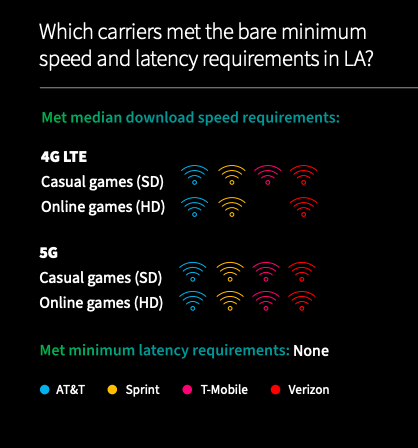RootMetrics finds that early 5G deployments support the speeds, but not necessarily the latency, for intensive 5G gaming
With its higher speeds and lower latencies, 5G is widely expected to help fuel more widespread adoption of cloud gaming, because it can support a responsive, smooth gaming experience on mobile. Operators around the world are striking partnerships to prepare for that 5G use case.
But will 5G really be a gamechanger for cloud gaming?—particularly in the early days of Nonstandalone 5G, in which reducing latency depends more on the concurrent deployment of edge computing resources, than on 5G itself? RootMetrics took a look at the four carrier 5G networks in Los Angeles, California, to find out.
Los Angeles, RootMetrics noted in its new cloud gaming report, is not only one of the first markets where all the national carriers have 5G service available, it is also a location that drives entertainment trends — so it’s particularly relevant to look at how well cloud gaming can perform for users there.
RootMetrics looked at the “bare minimum” download speeds and latency requirements from three cloud gaming platforms: Google Stadia, Microsoft xCloud, and Steam Remote Play. The company compared those requirements with its most recent mobile performance test results from Los Angeles, from the first half of 2020 (RootMetrics isn’t conducting current on-the-ground testing due to the pandemic), and factored in the effects of jitter and packet loss on the overall experience.
RootMetrics looked at that data through the lens of two playing scenarios: single-player, casual games such as Candy Crush or Tetris, in standard definition (720p); and multi-player, high-definition (1080p) games such as Madden NFL 2020, Fortnite or Call of Duty.
The benchmarking company pointed out that in some ways, streaming games from the cloud is similar to video streaming. But the user has far more influence: his or her command inputs “guide every stage of the game.” Every push of a button or press on the screen has to go from the device to the gaming service’s platform, be received and executed, and then travel back to the device. Mobile phones don’t have the processing power to handle the amount of data involved, but processing the data in the cloud can solve that — if you have good enough speeds and latency.
“In order for cloud gaming to reach a point where it’s capable of truly replacing the gaming experience found on PCs or consoles, connectivity must be consistent and nearly flawless, with fast speeds and ultra-low latency, particularly for fast-paced, multiplayer online games that require precision and quick reactions,” RootMetrics said. “We’re not at that point quite yet, but that’s where the future of 5G and cloud gaming is headed.”
RootMetrics found that all four national carriers (now technically three, although Sprint and T-Mobile US’ networks are still in the early days of being integrated) met the median download speed requirements for the cloud gaming services. That held true for both the operators’ 5G and also their 4G networks — with one exception. T-Mobile US’ LTE ran into trouble on speeds for high-definition gaming.
However, RootMetrics found that in terms of latency, none of the carriers’ networks — 5G or 4G — met the game services’ required latency metrics, which were between 10-30 milliseconds. And latency, the company said, “is critical for gamers—even more so than speed—and the lower the latency, the better. After all, when you press the “fire” button, you need to know you’ll hit your mark immediately or it’s game over. High latency can disrupt (or even stop) a game in mid-stream, while low latency can provide smooth, buffer-free gaming.”
In fact, RootMetrics found that for three out of the four networks, latency on 5G was actually higher than on the carrier’s 4G network:
- AT&T: 4G latency, 44 ms; 5G latency, 45.5 ms
- Sprint: 4G latency, 95 ms; 5G latency, 127 ms
- T-Mobile US: 4G latency, 77.3 ms; 5G latency, 76.5 ms
- Verizon: 4G latency, 97.5 ms; 5G latency, 121 ms

Even with those numbers, though, casual gamers are going to be able to crush their candies just fine on mobile networks. It’s the Fortnite and Call of Duty players who are most likely to see their game play differ significantly on mobile.
“The 5G landscape is changing fast and the carriers are making great progress, but it will take time before gamers can put away their consoles and start entering Esports competitions on smartphones. Indeed, new technologies always take time to expand and mature,” RootMetrics concluded.
Read the full report here.

